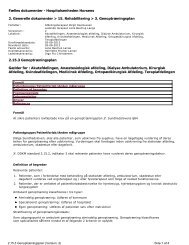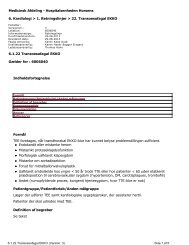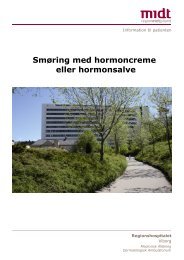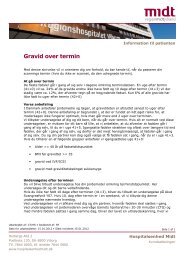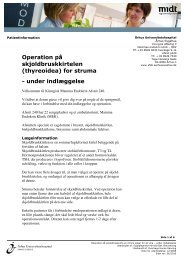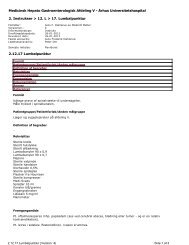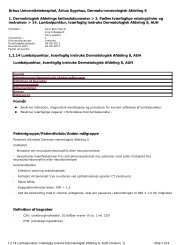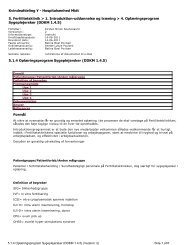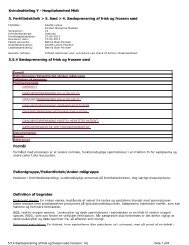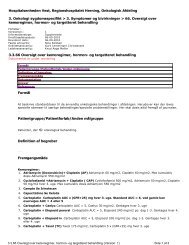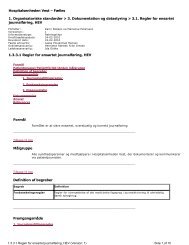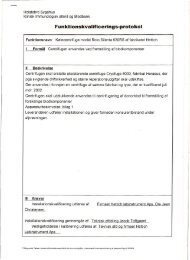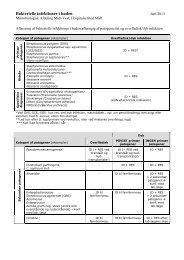12.5.2.30 DHS rekommandationer for KMT 2011.pdf - e-Dok
12.5.2.30 DHS rekommandationer for KMT 2011.pdf - e-Dok
12.5.2.30 DHS rekommandationer for KMT 2011.pdf - e-Dok
Create successful ePaper yourself
Turn your PDF publications into a flip-book with our unique Google optimized e-Paper software.
unrelated transplant in first complete remission. J Clin Oncol, 22, 2816-2825.<br />
Hunault M, Harousseau J-L, Delain M, Truchan-Graczyk M et al (2004). Better outcome of adult lymphoblastic<br />
leukemia after early genoidentical allogeneic bone marrow transplantation (BMT) than after late high-dose<br />
therapy and autologous BMT: a GOELAMS trial. Blood, 104, 3028-3037.<br />
Ribera JM, Oriol A, Bethencourt C et al (2005). Comparison of intensive chemotherapy, allogeneic or autologous<br />
stem cell transplantation as post-remission treatment <strong>for</strong> adult patients with high-risk acute lymphoblastic<br />
leukemia. Results of the PETHEMA ALL-93 trial. Haematologica, 90, 1346-1356.<br />
Yanada M, Matsuo K, Suzuki T, Naoe T (2006). Allogeneic hematopoietic stem cell transplantation as part of<br />
postremission therapy improves survival <strong>for</strong> adult patients with high-risk acute lymphoblastic leukemia: a<br />
metaanalysis. Cancer, 106, 2657-2663.<br />
Goldstone AH, Richards SM, Lazarus HM, et al (2008). In adults with standard-risk acute lymphoblastic<br />
leukemia, the greatest benefit is achieved from a matched sibling allogeneic transplantation in first complete<br />
remission, and an autologous transplantation is less effective than conventional consolidation/maintenance<br />
chemotherapy in all patients: final results of the International ALL trial (MRC UKALL XII/ECOG E2993. Blood,<br />
111. 1827-1833.<br />
Marks DI, Wang T, Pérez WS, Antin JH, Copelan E, Gale RP, George B, Gupta V, Halter J, Khoury HJ, Klumpp<br />
TR, Lazarus HM, Lewis VA, McCarthy P, Rizzieri DA, Sabloff M, Szer J, Tallman MS, Weisdorf DJ. The outcome<br />
of full-intensity and reduced-intensity conditioning matched sibling or unrelated donor transplantation in adults<br />
with Philadelphia chromosome-negative acute lymphoblastic leukemia in first and second complete remission.<br />
Blood. 2010 Jul 22;116(3):366-74. Epub 2010 Apr 19.<br />
Mohty M, Labopin M, Volin L, Gratwohl A, Socié G, Esteve J, Tabrizi R, Nagler A, Rocha V.<br />
Reduced-intensity versus conventional myeloablative conditioning allogeneic stem cell transplantation <strong>for</strong><br />
patients with acute lymphoblastic leukemia: a retrospective study from the European Group <strong>for</strong> Blood and<br />
Marrow Transplantation.<br />
Blood. 2010 Aug 17. [Epub ahead of print]<br />
Ph+ ALL, allo-HCT og imatinb<br />
Avivi I, Goldstone AH (2003). Bone marrow transplant in Ph+ ALL patients. Bone Marrow Transplantation, 31,<br />
623-632.<br />
Yanada M, Takeuchi J, Sugiura I et al (2006). High complete remission rate and promising outcome by<br />
combination of imatinib and chemotherapy <strong>for</strong> newly diagnosed BCR-ABL-positive acute lymphoblasic leukemia:<br />
a phase II study by the Japan Adult Leukemia Study Group. J Clin Oncol 24, 460-466.<br />
Wassmann B, Pfeifer H, Goekbuget N et al (2006). Alternating versus concurrent schedules of imatinib and<br />
chemotherapy as front-line therapy <strong>for</strong> Philadelphia-positive acute lymphoblastic leukemia (Ph+ ALL). Blood,<br />
108, 1469-1477.<br />
21



